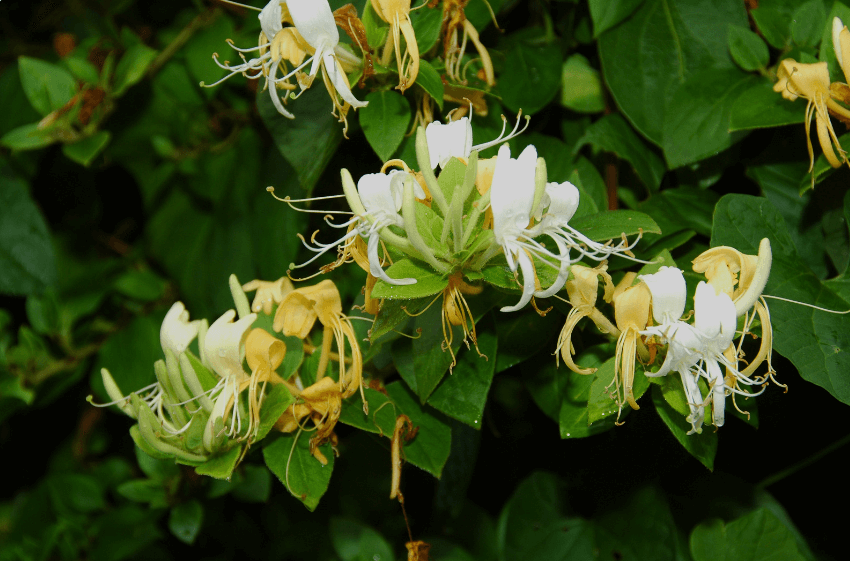
Honeysuckle
Share

Common Name Woodbine,Trumpet Honeysuckle ,Japanese Honeysuckle Family Name Caprifoliaceae
Parts Used Flowers,Leaves,Bark,Berries
Herbal Actions Antibacterial, Anti-inflammatory, Antipyretic, Antiviral, Diaphoretic
Health Benefits Immune Support, Skin Health, Anti-inflammatory Effects
What are the Benefits of Honeysuckle?
Honeysuckle, treasured for centuries across Asia and in Traditional Chinese Medicine (TCM), is celebrated as a potent natural remedy for its health-promoting properties.* Energetically, this plant is considered to have cooling effects that harmonize with the body's yin energy. It's sweet in flavor and gentle in action, making it a fundamental herb in TCM, commonly used to enhance health and prolong life.
Rich in bioactive compounds such as chlorogenic acid, luteolin, and inositol, honeysuckle flowers act as powerful antioxidants and anti-inflammatory agents. These properties support the body's natural defenses against oxidative stress and inflammation.* Renowned for its benefits to the respiratory system, honeysuckle is used to treat infections like colds and flu, thanks to its antiviral and antibacterial effects.
Honeysuckle is more than just a medicinal herb; it is also incorporated into daily culinary practices, infusing teas, syrups, and even desserts with its delightful fragrance and flavor. This versatile use underscores its role in promoting not only physical health but also enhancing the quality of everyday life, making honeysuckle a cherished ingredient in both traditional remedies and culinary creations.
Historical Use of Honeysuckle
Honeysuckle, particularly valued for its sweet scent and healing properties, has historically played a significant role in various cultural traditions, including those of Indigenous and Eastern communities. The plant, known for its beautiful, trumpet-shaped flowers, was more than just an ornamental or medicinal herb; it was often imbued with spiritual significance.
In traditional Eastern practices, particularly within Chinese medicine, honeysuckle was used extensively not only for its health benefits but also in spiritual rituals aimed at cleansing and protecting. Its flowers and stems were frequently included in herbal formulas designed to purify the home and the individual, believed to ward off negative energies and promote a harmonious environment.
Similarly, Indigenous communities might have recognized honeysuckle for its inherent qualities that align with nature's cycles and spiritual beliefs. Although specific historical references to Indigenous uses of honeysuckle like those of the Iroquois with wild cherry might not be well-documented, it is plausible that such communities could have used honeysuckle in their own traditional ways. They may have employed honeysuckle flowers in ceremonies that celebrate the beginning of spring or used its medicinal properties in healing rituals, appreciating the plant for its ability to promote health and spiritual well-being.
Honeysuckle's versatility was evident in its use across various domains of life—from health care to spiritual protection. This historical usage reflects a deep understanding of the plant’s properties and a profound respect for nature's gifts, highlighting honeysuckle's role in both physical and spiritual realms.
Botanical Description & Habitat
Honeysuckle plants are part of the genus Lonicera and include both shrubby and climbing varieties, widely appreciated for their sweetly scented, tubular flowers. The most commonly recognized forms are climbing vines, which use twining stems to climb up trellises, fences, and other supports.
The leaves of honeysuckle are typically opposite, simple, oval to lanceolate, and either deciduous or evergreen, depending on the species. The leaves are often 1-10 cm long, and some species have hairy undersides.
Honeysuckle flowers are known for their vibrant, fragrant blooms that appear in a wide range of colors including white, yellow, pink, and red. These flowers are usually produced in pairs from the axils of the leaves and can be tubular, funnel-shaped, or bell-shaped, blooming from spring to summer. The fruit is a small red, blue, or black berry containing several seeds, but not all honeysuckle berries are edible.
Honeysuckles (Lonicera spp.) are adaptable to a wide range of climates and can be found across the Northern Hemisphere including North America, Europe, and Asia. They thrive in full sun to partial shade and prefer well-drained soil but can adapt to many soil types.
In the wild, honeysuckle often grows along the edges of forests, in hedgerows, and along riverbanks where they have ample support for climbing. Some species are well adapted to garden cultivation and are often planted for their ornamental value and their ability to attract pollinators such as bees, butterflies, and hummingbirds.
Because of their vigorous growth habit, some species of honeysuckle, particularly Lonicera japonica (Japanese honeysuckle), can become invasive outside their native range, overwhelming native plants and disrupting local ecosystems.
